

Product guy who does research from time to time

Table of Contents
Introduction: The Largest Blockchain Conference in Europe, EthCC Paris, Kicks off
Infrastructure in Progress
#1: Account Abstraction
#2: PBS & PBS on Rollups(L2)
#3: zkEVM
#4: L2 Stack
Closing Thoughts: Amidst the Bear Market, Ethereum's Focus Shifts toward Infrastructure
Introduction: The Largest Blockchain Conference in Europe, EthCC Paris, Kicks off
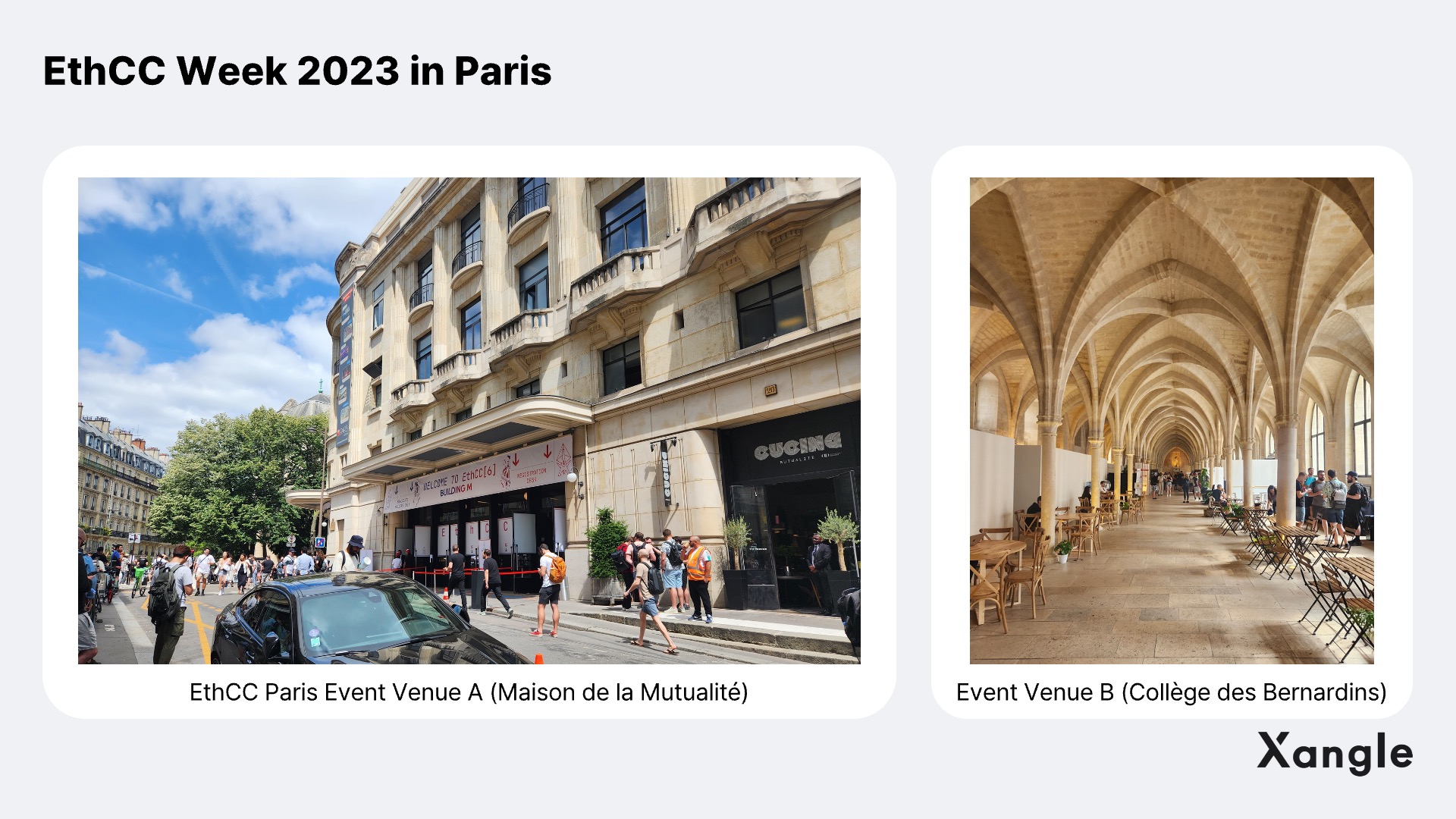
Xangle had the opportunity to participate in the Ethereum Community Conference (EthCC), a premier annual event scheduled for July 17-20. Organized by Jerome de Tychey of the Ethereum France community since 2016, EthCC has steadily grown over the years to become Europe’s largest Ethereum conference. This year's EthCC [6] brought together 250+ speakers from the Ethereum ecosystem, among whom were some of the greatest minds in blockchain such as Ethereum co-founder Vitalik Buterin, Starknet founder Eli Ben-Sasson, and Chainlink co-founder Sergei Nazarov, sharing valuable insights and knowledge.
During the EthCC, Paris also hosted several side events, creating what could be aptly described as a crypto festival week. Among these events were StarkNetCC, a community conference centered around the STARK Proof of Work, and the Modular Summit, which focused on envisioning a modular future for all chains, including Ethereum. Additionally, there was the L2 day, dedicated to sharing insights from L2 solutions and rollups, and Infracon, where Xangle participated. Throughout these events, I experienced the palpable excitement that continues to build amidst the bear market in Ethereum and the broader crypto space.
 Infracon Paris | Lihan Lee, Co-CEO of Xangle, presenting Adoption 2023 and Xangle’s business model
Infracon Paris | Lihan Lee, Co-CEO of Xangle, presenting Adoption 2023 and Xangle’s business model
Scaling the Ethereum Infrastructure
The central theme that permeated the discussions revolved around the Ethereum infrastructure. With market liquidity dwindling and Ethereum facing limitations in terms of clear use cases, the crypto ecosystem, including Ethereum, is in the process of transforming the blockchain into a more efficient and user-friendly network, ultimately driving it closer to mass adoption. This approach emphasizes streamlining the underlying infrastructure rather than solely experimenting at the application level.
The main discussions during the event were grouped into four pivotal categories:
- Improving UX through Account Abstraction
- Transitioning the Ethereum network to a more robust system with the widespread adoption of PBS
- Building a highly scalable trustless execution environment for rollups with zkEVM
- Developing Rollup-as-a-Service (RaaS) and Stack solutions to facilitate the launch of custom rollups or chains
Aside from the four main categories above, the EthCC covered a wide array of interesting topics, including Token Engineering, a concept leveraging tokens to drive dApp growth, implications of MICA, discussions on the L2 governance, and unveilings of new models. However, this article will primarily focus on the intriguing sessions related to the infrastructure categories outlined earlier, focusing on the changes occurring within the infrastructure space.
Infrastructure in Progress #1: Account Abstraction
History of AA
The Account Abstraction (ERC-4337) deployed at EthDenver this year was by far the most captivating and widely discussed topic during the Paris Crypto event week. ERC-4337 introduced innovative actors such as UserOperation, Bundler, and Paymaster to deploy and support a separate contract known as the EntryPoint Contract, and remarkably, this is achieved without modifying the Consensus Layer and I've always wondered why AA was deployed as a separate smart contract rather than being integrated at the consensus level. This curiosity was addressed in Vitalik Buterin's session on the History of Account Abstraction session, where he traced the five-year history of AA’s development.
 EthCC - Vitalik Buterin | History of Account Abstraction, Source: Subin An
EthCC - Vitalik Buterin | History of Account Abstraction, Source: Subin An
Vitalik explained that the initial intention was to incorporate the functionality of AA directly into the protocol. However, to achieve the dual objectives of enhancing user security and improving UX improvements, they had to address the verification complexities related to verification and txHash uniqueness, which were evident in earlier AA models like EIP-86. These challenges led to the development of ERC-4337. However, just as Ethereum's early multisig wallets were rejected for not fulfilling their design aspirations. Therefore, the question remains whether the ERC-4337 standard will transcend Ethereum to become a broader standard in the crypto space as other networks such as Near Protocol and zkSync have already implemented their own AA standards.
An absolute powerhouse of UX with AA: Argent Wallet
In the subsequent session, Julien Niset from Argent Wallet explained how AA has a tangible impact on real users. He delved into the wallet's structure, which has already integrated the concept of account abstraction.
 EthCC[6] | Julien Niset - The invisible wallet: how to make crypto magic
EthCC[6] | Julien Niset - The invisible wallet: how to make crypto magic
Julien elaborated on how AA has evolved into a standard abstraction within Ethereum and higher rollups, providing not only simple gas payments but also simplifying transactions (Transaction, Approval → Single Execution). This streamlines the process and allows for smoother execution within a single transaction. Additionally, AA enables the implementation of social recovery, allowing private keys to be recovered through relationships with other wallets, in contrast to the existing recovery method that relies solely on a single private key. Argent Wallet particularly incorporates three guardians whose sole purpose is recovery, presenting a significant enhancement to the existing structure that relies only on the user's private key (mnemonic).
LUKSO: UX-specific mainnet
 EthCC[6] | Fabian Vogelsteller - How LUKSO will UP!grade the blockchain user experience
EthCC[6] | Fabian Vogelsteller - How LUKSO will UP!grade the blockchain user experience
Among the remarkable projects pushing the boundaries of user experience (UX) is LUKSO, a prominent sponsor of EthCC and the creator of an entire network integrating all the new features introduced in AA. As an EVM-compatible L1 solution, LUKSO has already successfully implemented advanced functionalities such as Social Recovery and Gas Fee Station. These innovative features are currently under discussion by Fabian Vogelsteller, one of the ERC-20 co-authors, who is actively promoting the adoption of the LSP-0 Universal Profile rooted in ERC-725. LUKSO's bold move to pre-adopt these advanced features is commendable, but its ultimate success will hinge on its ability to attract enough users through a comfortable and intuitive UX.
Infrastructure in Progress #2: PBS & PBS on Rollups(L2)
Go Modular, PBS in Progress
 Modular Summit event venue, located in Quartier Latin
Modular Summit event venue, located in Quartier Latin
The Modular Summit saw extensive discussions revolving around Proposer Builder Separation (PBS). PBS aims to address the challenges that emerged after Ethereum transitioned to Proof of Stake (PoS). With validators gaining more power, concerns over the MEV issue, also known as the Dark Forest, continued to affect users adversely. PBS seeks to alleviate these concerns by separating block construction, creation, and execution functions, which were previously consolidated under validators. For complimentary reading, see Xangle's “MEV (Maximal Extractable Value): The Greatest Challenge for Blockchain to Overcome.”
However, starting with the first solution, MEV-boost, the research on the optimistic relay, Enshrined PBS (ePBS), and its variants, 2-shot PBS, PTC, and PEPC, has been fragmented in different forums, making it difficult to understand the reasons for the development of the various models and their differences at a glance.
 Modular Summit | Mike Neuder - Ethereum PBS R&D Roadmap
Modular Summit | Mike Neuder - Ethereum PBS R&D Roadmap
At the Modular Summit, Mike Neuder, a researcher at the Ethereum Foundation, presented a heart-shaped diagram illustrating the differences between off-chain and on-chain validation methods. In the current relay structure, the optimistic relay is seeking to implement MEV-Boost as a peer-to-peer optimal layer between builders and proposers. On the other hand, on-chain PBS (Enshrine) is working on Vitalik's proposed 2-shot PBS, Payload-timeliness Committee (PTC) with a timeless committee, and a more open system that validates only at the block level through protocol-enforced proposer commitments (PEPC). This comprehensive explanation provided a clear understanding of the PBS model.
Implementing PBS at the protocol level demands meticulous consideration, similar to the changes required at the consensus layer. Thus, immediate enshrinement of the current off-chain relay and MEV boost seems unlikely. Instead, it is expected to gradually evolve into an optimistic relay, further developed through solutions such as two-shot PBS, PTC, PEPC, and other upcoming discussions. Similar to ERC-4337, which has only recently become a standard, the journey toward a well-established PBS framework will be a gradual and extensive process.
Recognizing new possibilities in L2: Shared Sequencing Layer
The PBS architecture, originally designed to separate the roles of creating, executing, and validating blocks, is finding application in L2, specifically in the rollup ecosystem, albeit for slightly different purposes. According to Ben Fisch, CEO of Espresso Systems, there is a demand for a 1.5-level layer to help builders in creating blocks efficiently in a cross-rollup environment while simultaneously enhancing the overall robustness of the Layer 2 rollup ecosystem, which is primarily responsible for execution.
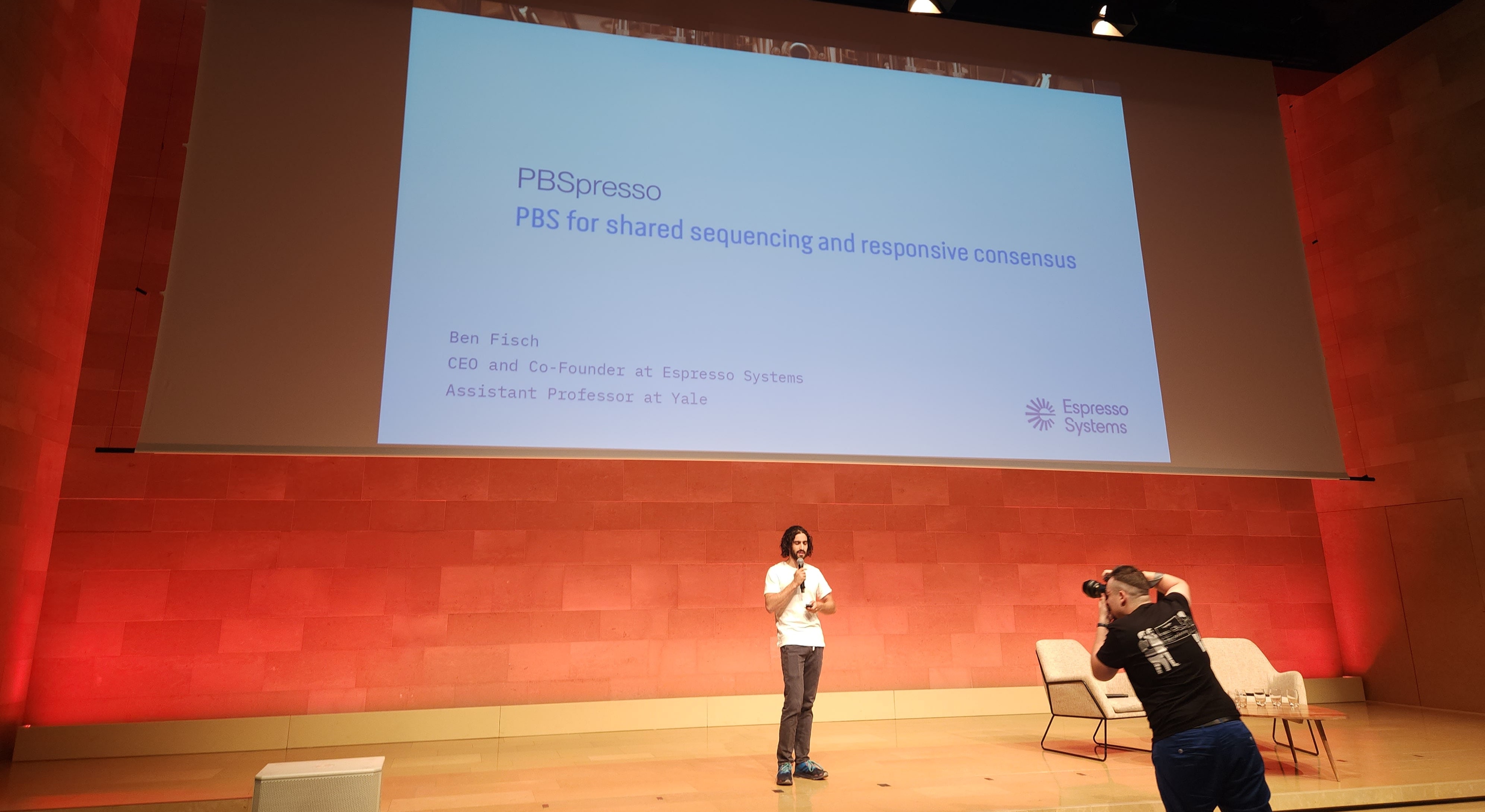 Modular Summit | Ben Fisch - PBSpresso, PBS for shared sequencing and responsive consensus
Modular Summit | Ben Fisch - PBSpresso, PBS for shared sequencing and responsive consensus
Espresso is building a network of decentralized sequencers (proposers) that rival the speed of centralized sequencers leveraging Hotshot, a Responsive Consensus algorithm that boasts theoretically zero block generation time. By designing the Proposer Network, Espresso aims to provide an environment where builders delivering blocks to proposers can focus solely on building blocks without concerns about duplicate submissions of already executed transactions.
Meanwhile, there are other shared sequencer projects that focus more on builders. At StarknetCC, Tariz, co-founder of Radius, explained their strategy of pre-allocating the first half of the blockspace to users and utilizing PVDE to prevent bad MEVs (frontrunning), while the second half of the block uses solutions like MEV-Boost and SUAVE to protect users and consider the profitability of the rollup. Tariz also proposed leveraging the shared sequencing layer as a communication tool to build a consistent state between rollups.
 StarkNetCC | Tariz Jeong - A sequencing layer to make app-specific rollups sustainable
StarkNetCC | Tariz Jeong - A sequencing layer to make app-specific rollups sustainable
Additionally, shared sequencing layers are gaining traction as a fundamental component of L2 solutions. Notably, PBS schemes such as Astria have been making use of Celestia's DA layer as an intermediate layer to achieve fast completeness between rollups. For a more in-depth exploration of this topic, check out Xangle's article on shared sequencing networks.
Infrastructure in Progress #3: zkEVM
Join the Ethereum cartel - zkVM to zkEVM
 zkEVM can be categorized into several types according to its compatibility, and the lower the type, the more compatible it is with EVM. (Source: EthereumDaily)
zkEVM can be categorized into several types according to its compatibility, and the lower the type, the more compatible it is with EVM. (Source: EthereumDaily)
One of the advantages of a network adopting the same execution environment as Ethereum is its ability to lower barriers to entry for new projects, providing easier access to 1) liquidity and 2) development environments (Solidity, Vyper, Token Standard, Infura, Foundry, Hardhat, and others.). EVM compatibility has enabled Avalanche (C-Chain) and BNB (Ethereum with Proof of Authority) to emerge as major mainnets in the past. Furthermore, implementations of zkVM, a zero-knowledge proof-of-concept virtual machine that was once considered a distant future prospect, began to materialize, while efforts to implement zkEVM with EVM compatibility are also yielding promising results.
Consensys launches Linea mainnet, a zkEVM-based rollup
 EthCC[6] | Olivier Bégassat - Linea under the hood: from arithmetizatio to prover
EthCC[6] | Olivier Bégassat - Linea under the hood: from arithmetizatio to prover
In March, Consensys, a company dedicated to building crypto-ecosystem infrastructure and known for its famous product MetaMask, launched its Linea rollup based on the zkEVM it has been developing. Moreover, during the EthCC week, they released the alpha version of the rollup's mainnet, and Olivier Bégassat from Consensys provided explained Linea's zkEVM development roadmap. He mentioned that the current implementation in Linea is classified as Type 3, but the company is working towards achieving Type 2 zkEVM by Q3 for compatibility with the Ethereum API and a similar gas calculation method. Currently, the only teams working on lower levels of compatibility than Type 2 in the market are Scroll and Taiko (Type 1). It will be interesting to see if Consensus, the team behind well-established development tools such as Infura, Truffle, the Teku client, and other mature development tools, can achieve yet another impressive feat.
Kakarot zkEVM, a new project backed by Vitalik Buterin
 StarknetCC | Discussing Kakarot - Sam Benyakoub, Elias Tazartes, Abdelhamid Bakhta, Vitalik Buterin, Shahar Papini
StarknetCC | Discussing Kakarot - Sam Benyakoub, Elias Tazartes, Abdelhamid Bakhta, Vitalik Buterin, Shahar Papini
On the other hand, we have observed slightly different approaches in zkEVM implementations, such as Starknet's Kakarot. Starknet employs CairoVM, a zkVM specialized for STARK proofs, rather than zkEVM. Consequently, deploying a smart contract written in Solidity on Starknet necessitates either creating a new port to Cairo or utilizing a Solidity >> Cairo transpiler (Warp), which may introduce inefficiencies. In response to this challenge, the community-driven project Kakarot was initiated as a solution. While some discussions have surfaced suggesting that Starknet should focus more on streamlining the execution and compression of STARK proofs over developing zkEVM, sessions at StarknetCC and, notably, EthCC [6] have led to the realization that Kakarot's emergence is primarily focused on ensuring the survival and prosperity of Starknet, rather than serving Ethereum alone.
 Kakarot smart contracts can execute arbitrary EVM bytecodes, deploy EVM contracts, and execute function calls.
Kakarot smart contracts can execute arbitrary EVM bytecodes, deploy EVM contracts, and execute function calls.
This is because Kakarot is an implementation of Ethereum Virtual Machine (EVM) written in Cairo (similar to how Geth's EVM is written in Golang). While it may be less efficient and slower compared to developing a circuit for EVM, Kakarot enables the creation of a self-contained ecosystem based on StarkNet using Cairo. Moreover, it allows seamless communication between contracts written in Solidity for the existing Ethereum network and contracts based on Cairo. Hence, implementing zkEVM, such as Kakarot, can be considered a commendable effort in combining CairoVM's specialized capabilities with STARK proofs within the StarkNet ecosystem, while maintaining compatibility with Ethereum – achieving dual objectives simultaneously.
Infrastructure in Progress #4: L2 Stack
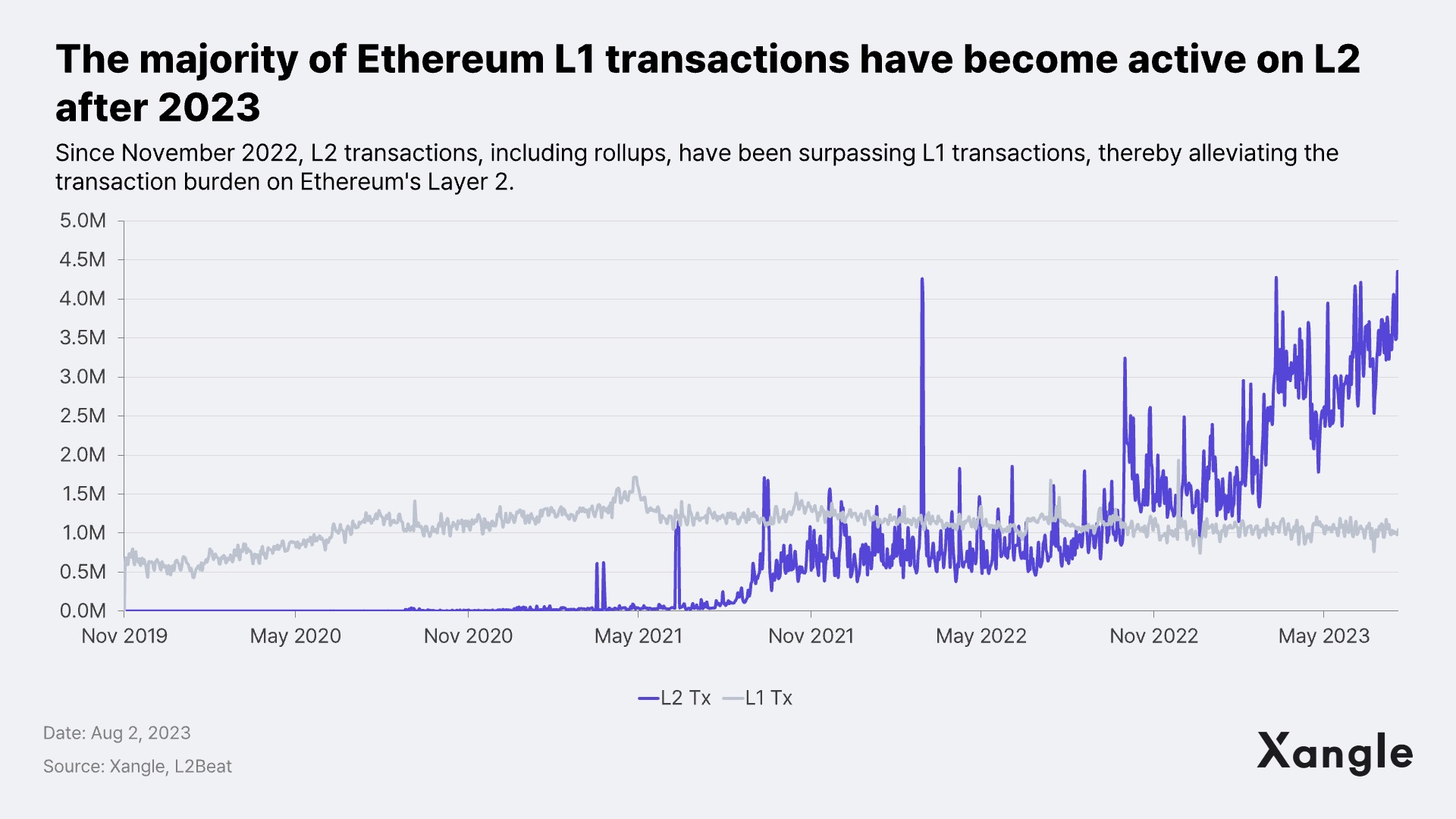
Currently, scaling solutions for Layer 2 on top of Ethereum encompass a combination of vertical scaling, such as Starknet's Fractal Scaling, and horizontal scaling through solutions like OP Stack. Notably, there has been a recent surge in the emergence of SDKs that simplify the process of launching projects within the L2 ecosystem. Several prominent solutions include Optimism's OP Stack, zk Sync's zk Stack, Arbitrum Nitro, Celestia's Rollkit leveraging DA, and various stack solutions, each facilitating the easy deployment of rollups. This dynamic landscape has led to the proliferation of rollup solutions, and the “Rollup Wars” have begun.
The anticipation lies in the expansion of OP Stack-based rollups, with Coinbase's Base at the forefront
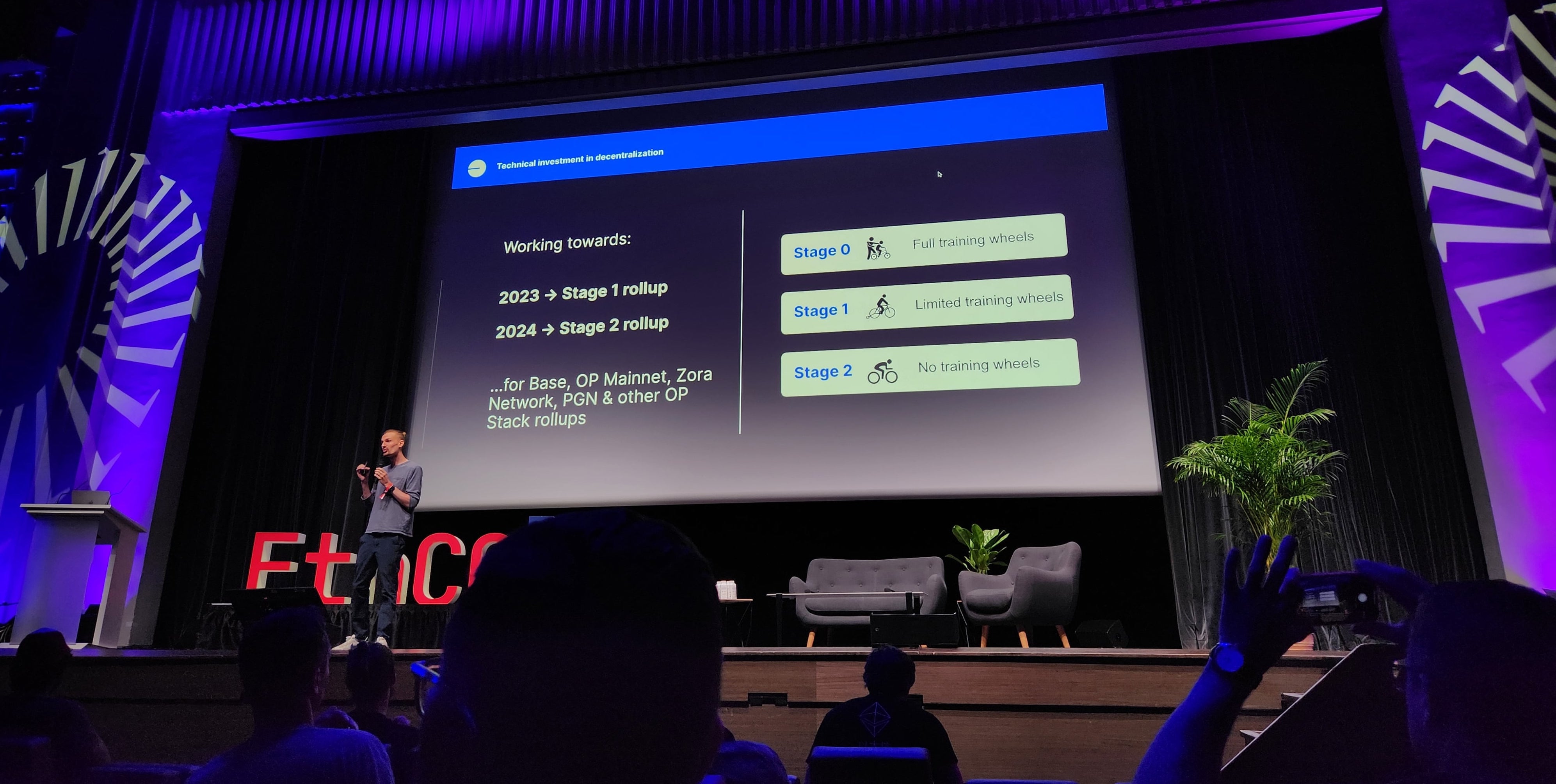 EthCC[6] | Jesse Pollack - Base’s commitment to decentralization
EthCC[6] | Jesse Pollack - Base’s commitment to decentralization
One of the most significant is Coinbase's Base rollup, currently being developed on top of Optimism's Op Stack. During the EthCC main stage, Jesse Pollock of Coinbase emphasized the importance of decentralization, outlining a three-stage roadmap (Stages 0, 1, and 2) along with three key commitments aimed at achieving robust decentralization within the rollup framework: 1) Investing in technical infrastructure for decentralization, 2) participating in the network through a neutral and permissionless framework, and 3) supporting funding for public goods. While it might appear paradoxical for a major player like Coinbase to advocate for decentralization, the company’s track record in web3 ventures such as $cbETH suggests the feasibility of their stance. Regardless, the ongoing involvement of major players like Coinbase and Bybit's Mantle, as they continue to onboard to the OP Stack and contribute to the Optimism Collective via transaction fees sets the stage for a promising future of the Optimism ecosystem built upon the OP-Stack.
DA-based RaaS: Celestia Rollkit
 Modular Summit | NashQ - Rollkit: Unleashing the Power of Open Interfaces
Modular Summit | NashQ - Rollkit: Unleashing the Power of Open Interfaces
Rollkit, an Open Interface RaaS solution, is currently under development by a team that spun out Rollkit from Celestia Labs, the developers of the modular DA network. This innovative solution empowers users to assemble and deploy rollups of their choice. At the Modular Summit, developer NashQ explained the background, structure, and future roadmap of Rollkit. He explained that Rollkit is built upon Cosmos SDK and ABCI, enhanced with features like Sequencing API, and DA Interface. As it operates on an open interface, users can flexibly develop a sequencer/bridge/DA/ Statemachine (VM, Execution). Much akin to the Cosmos SDK’s modularity, Rollkit allows the integration of diverse modules, with plans underway to unveil the Bitcoin Based Rollup – leveraging Bitcoin as a DA – in mid-April 2024. It stood out as a promising RaaS solution for the future, with the anticipation that it could attract the same level of attention from developers as the Cosmos SDK does.
The emergence of zk RaaS: zkSync zk Stack
 EthCC[6] | Kalman Lajko - Hyperchains and Hyperbridges: How the ZK Stack will power the Internet of Value
EthCC[6] | Kalman Lajko - Hyperchains and Hyperbridges: How the ZK Stack will power the Internet of Value
As the once intricate implementations of zkEVM and zkRollup have grown more concrete, we are witnessing the gradual emergence of RaaS services that leverage zkRollup as stack solutions. ZK Stack, a Type 4 zkEVM rollup, and zkSync Era developed by Matter Labs, stand out as a prime illustration. Announced in June of this year, ZK Stack has become a prominent example in this category. During the EthCC event, Kalman Lajko from Matter Labs underscored the merits of the advantages of launching a hyperchain through ZK Stack. These advantages encompass fast cross-chain messaging (L3 Fast Messaging) and proof aggregation, and low proof cost.
StarkNet Stack
 EthCC[6] | Eli Ben-Sasson - Starknet Vision
EthCC[6] | Eli Ben-Sasson - Starknet Vision
During this year's Paris Crypto Week, the spotlight was on the unveiling of yet another ZK Rollup RaaS service. Enter the StarkNet Stack, introduced by none other than StarkNet founder, Eli-Ben-Sasson. The StarkNet Stack distinguishes itself by its commitment to decentralize all integral components – Full Node, Execution Engine, Sequencer, Prover, and more – to construct a comprehensive zero-knowledge proof framework. Similar to Ethereum’s approach, the development/maintenance of its execution and consensus clients involve multiple entities. Remarkably, there isn’t just one solution for Sequencer, Full Node, and Prover; this multi-pronged approach appears to offer a more resilient network compared to other RaaS solutions. In addition, they revealed their determination to actively engage in the Ethereum L2 competition, not merely by unveiling the stack itself but also by introducing a futures trading DEX, named ParaDEX. This innovative DEX will take the shape of an L2 appchain within the StarknetCC.
Closing Thoughts: Amidst the Bear Market, Ethereum's Focus Shifts toward Infrastructure
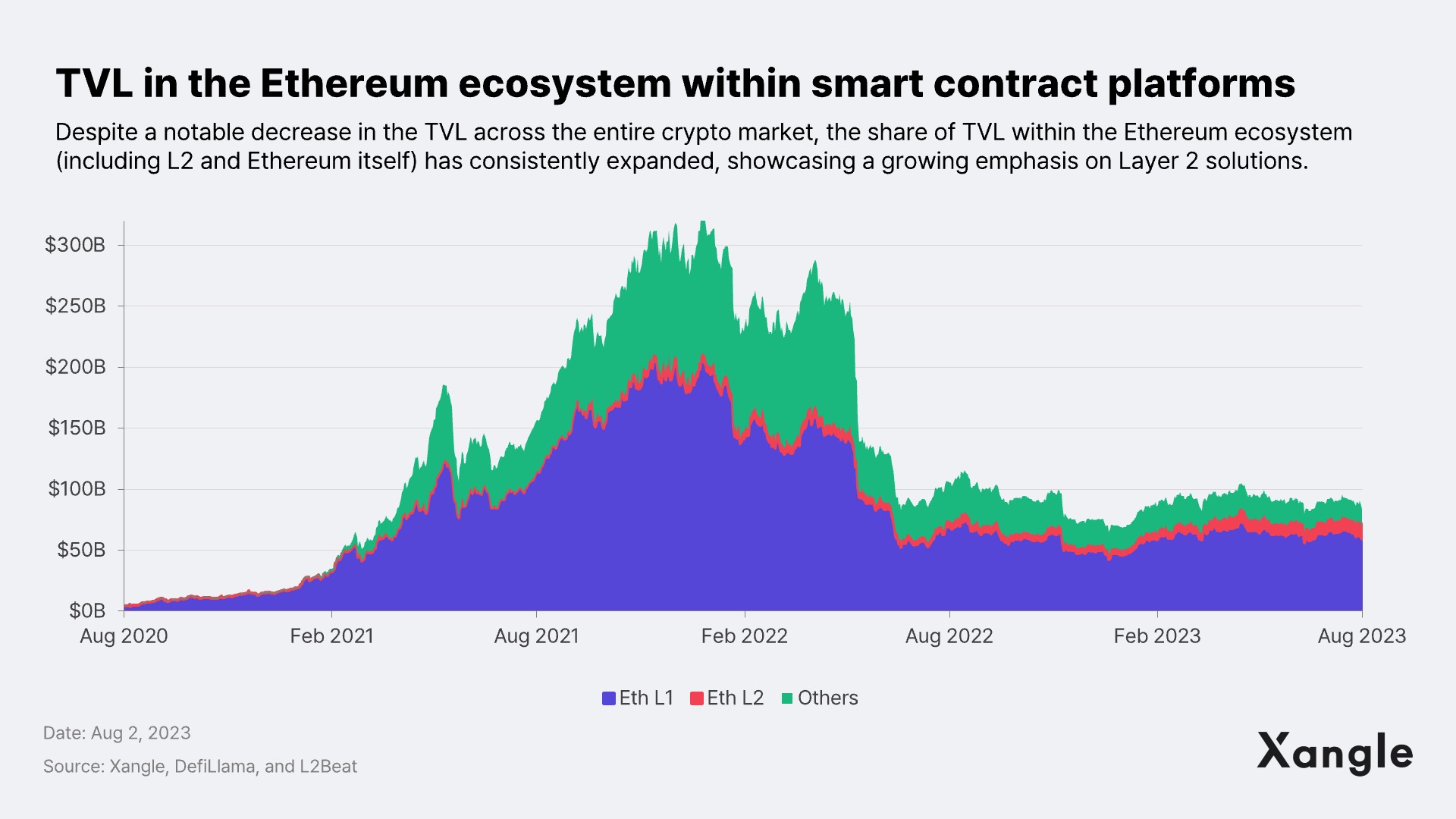
Amid a string of unforeseen events like UST-Depeg and FTX Bank Run, market liquidity has contracted. Nevertheless, the Ethereum ecosystem continues to wield significant influence, showcasing an impressive TVL of approximately $68.8B including L2 solutions. This represents roughly 83% of the TVL in the crypto market excluding Bitcoin. Moreover, similar to how various standards such as ERC-20, ERC-721, and ERC-1155, originating from the Ethereum ecosystem, have triggered transformative shifts in the crypto space, the introduction of new standards and research discussed within Ethereum holds significant sway as a foundational infrastructure that fosters innovation. Consequently, it remains imperative to consistently observe the progress of these advancements.
Competitive infrastructure expansion and the anticipated outcomes
Infrastructure-related research undergoing a transformation within Ethereum L2, as each entity engages in a competitive landscape to establish their own infrastructure. The competition has intensified particularly within the domain of zkEVM and Rollup Stack. Yet, the EthCC / Modular Summit offered a different perspective, highlighting collaboration over adversarial competition. The objective is to create better solutions that can collectively expand the market within the constraints of a smaller market.
 A great example of competitive cooperation: The scene at the EthGlobal Paris hackathon, which lasted three days and nights | Source: Team Heimdallr
A great example of competitive cooperation: The scene at the EthGlobal Paris hackathon, which lasted three days and nights | Source: Team Heimdallr
Cryptocurrencies Ethereum in particular, are confronted with a multitude of challenges to address: low scalability, user experience, privacy, censorship, and MEV, among others. Conversely, the consequences of excessive liquidity entering a market lacking sufficient infrastructure have also been evident. So while I was slightly disappointed by the lack of new applications and dApps during my time in Paris, I've come to realize and empathize with the necessity of this phase in the process. It’s the groundwork for what’s to come, which is why I'm eagerly anticipating the bull market phase that will unfold once the infrastructure is in place.
What shape will Ethereum look like in 2024, and what discussions will unfold at next year’s Ethereum conference, EthCC [7]? Can we expect to see more efforts to bridge the infrastructure gap and witness attempts to develop applications? With excitement for next year's EthCC[7] in Brussels, Belgium, I'll bring this account to a close.